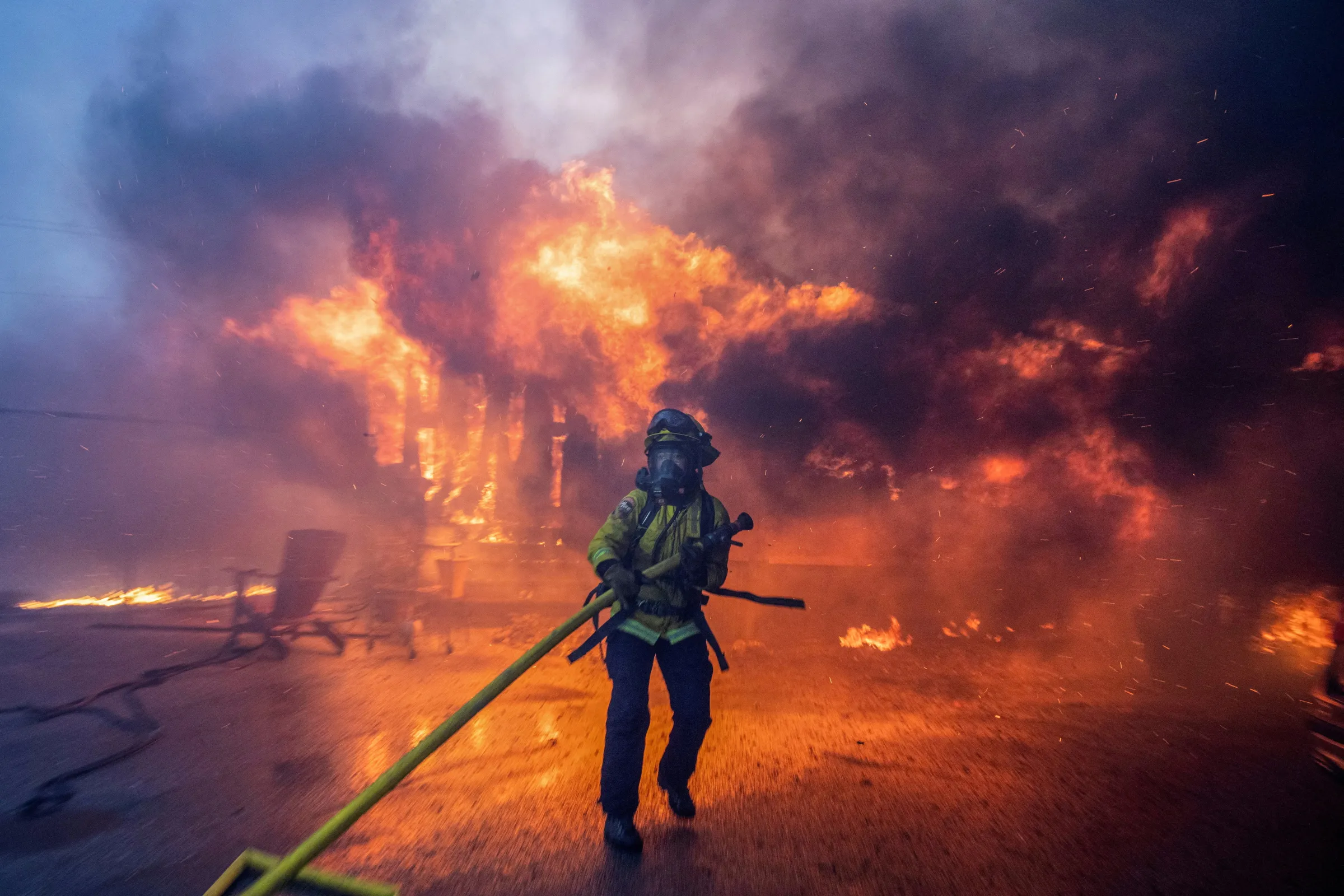Context is powered by the Thomson Reuters Foundation Newsroom.
Our Standards: Thomson Reuters Trust Principles

A firefighter battles the Palisades Fire as it burns during a windstorm on the west side of Los Angeles, California, U.S. January 7, 2025. REUTERS/Ringo Chiu
Here's why forest management and restoration are coming into focus amid deadly California wildfires
Forest, fuel load management can mitigate blazes
Prescribed burning spotty, controversial
Trump, Newsom feud over California wildfire response
RICHMOND, Virginia - The horrific Los Angeles area wildfires that have exploded across densely populated, suburban areas not accustomed to such destruction are raising questions about forest and fuel load management and how to mitigate blazes fueled by climate change.
California Gov. Gavin Newsom said in a video posted to social media that this is not traditionally thought of as fire season, but the scenario has changed.
"Now, we disabuse any notion that there is a season - it's year-round in the state of California," he said.
As firefighters tamp down the flames and public officials grapple with what comes next, here's what to know about forest management, preservation and restoration and the role these factors play in helping mitigate wildfires:
Clearing brush through controlled or prescribed burns and the mechanical thinning of forests can help slow the spread of fires so that when they do ignite, they're not as intense.
Forests are also one of the best natural "carbon sinks" – meaning they pull climate-changing carbon dioxide out of the air and store it as they grow, helping lessen broader global warming effects that are fueling fire-friendly hotter and drier weather.
"There's absolutely no question that more forest management is needed in the United States to make our forests resilient to wildfire, and specifically to the increasing threat of wildfire that we're seeing driven by climate change," said Jad Daley, president and CEO of American Forests, a non-profit group.
Prescribed or controlled burns entail fire crews intentionally igniting sections of forest to clear out flammable vegetation and/or create proper conditions for other vegetation or wildlife.
The practice dates back at least to Native American tribes, but it has run into problems in recent years linked to public relations snafus where prescribed fires grew into out-of-control blazes as well as insurance concerns that make it difficult for smaller outfits to conduct the burns.
There are also environmental issues associated with the smoke that results from such burns.

A firefighter battles the fire in the Angeles National Forest near Mt. Wilson as the wildfires burn in the Los Angeles area, during the Eaton Fire in Altadena, California, U.S. January 9, 2025. REUTERS/Ringo Chiu
A firefighter battles the fire in the Angeles National Forest near Mt. Wilson as the wildfires burn in the Los Angeles area, during the Eaton Fire in Altadena, California, U.S. January 9, 2025. REUTERS/Ringo Chiu
Sometimes there simply aren't enough resources. The U.S. Forest Service reportedly halted prescribed burns in California toward the tail end of 2024 because firefighters were needed elsewhere.
Daley also cited the pushback that government agencies get when they conduct thinning and burning needed to help make forests resilient to wildfires.
"People say you're killing the forest," he said. "No, actually, we're saving the forest."
The state has invested at least $2.6 billion through 2028 in forest management to implement its Wildfire and Forest Resilience Action Plan, and 100% of the 99 key actions outlined in the plan are underway or completed, according to Newsom's office.
A 2021 investigation, however, found that Newsom had overestimated progress on wildfire resilience efforts at the time, overstating by 690% the number of acres treated with fuel breaks and prescribed burns on priority projects.

The wind whips embers as the Palisades Fire burns during a windstorm on the west side of Los Angeles, California, U.S. January 7, 2025. REUTERS/Ringo Chiu
The wind whips embers as the Palisades Fire burns during a windstorm on the west side of Los Angeles, California, U.S. January 7, 2025. REUTERS/Ringo Chiu
Trump, who has been engaged in a long-running feud with Newsom, has repeatedly said California needed to do more raking or cleaning of forest floors to combat the blazes.
This week, he criticized Newsom over water management policies that Trump said contributed to the state's wildfire issues.
"The Governor is focused on protecting people, not playing politics, and making sure firefighters have all the resources they need," Izzy Gardon, Newsom's director of communications, told Context.
Daley said discussions over forest management in the context of the wildfires are fair – to an extent.
"If you look at 'have we been doing enough in terms of wildfire resilience in the core of Los Angeles and parts of Los Angeles that are being impacted by this fire,' that feels like a somewhat unfair criticism because candidly, we hadn't really understood the level of risk that existed in some of these places," he said.
"This is an opportunity as a country, as opposed to dividing ourselves and saying why didn't somebody do this or that, it's actually an opportunity to say everyone needs a paradigm shift of what success looks like here," Daley said.
"Then we need to invest in programs that actually help communities do this work, help government agencies do this work."
(Reporting by David Sherfinski; Editing by Ellen Wulfhorst.)
Context is powered by the Thomson Reuters Foundation Newsroom.
Our Standards: Thomson Reuters Trust Principles